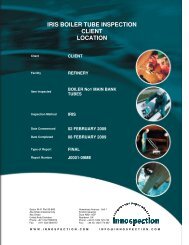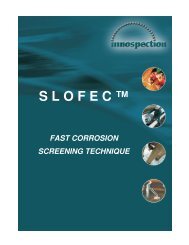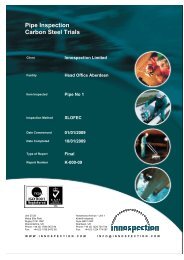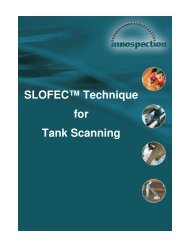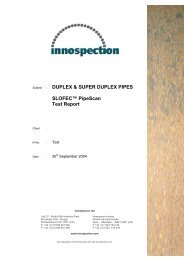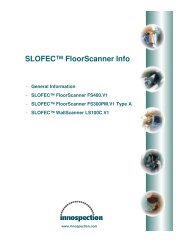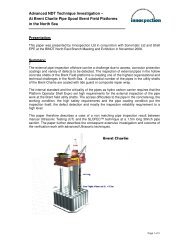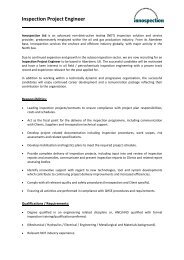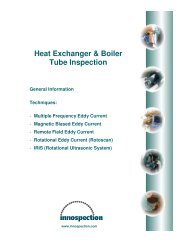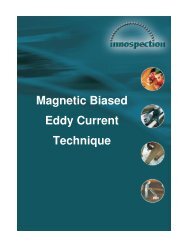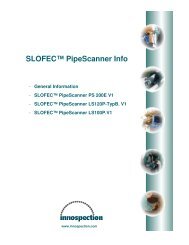SLOFEC Subsea Inspection - Innospection
SLOFEC Subsea Inspection - Innospection
SLOFEC Subsea Inspection - Innospection
Create successful ePaper yourself
Turn your PDF publications into a flip-book with our unique Google optimized e-Paper software.
<strong>SLOFEC</strong> Technique<br />
for<br />
<strong>Subsea</strong> <strong>Inspection</strong><br />
(Riser & Caisson)
<strong>SLOFEC</strong> Technique for <strong>Subsea</strong> <strong>Inspection</strong><br />
(Riser & Caisson)<br />
Internal Marinised Caisson Scanner<br />
The target of the internal caisson scanning tool is the inspection of the caisson pipes for the<br />
detection of internal and external corrosion from the inside as well as above and below water<br />
level.<br />
Our marinised internal caisson inspection tool is applicable for caissons with diameter<br />
between the ranges of 10” to 42”.<br />
Internal caisson scanning tool (side view)<br />
Internal caisson scanning tool<br />
Schematic diagram of the<br />
scanning tool being<br />
lowered into the caisson<br />
Internal caisson scanning tool being<br />
lowered into the caisson<br />
The marinised internal caisson inspection tool consists of the following systems:<br />
<br />
Magnetic Saturation - Eddy Current<br />
- For the detection of corrosion externally and internally with separate colour mapping<br />
- Able to report external condition mapping (wall loss in 10% steps)<br />
- Able to report internal condition mapping (wall loss in 10% steps)<br />
Page 2 of 9
<strong>SLOFEC</strong> Technique for <strong>Subsea</strong> <strong>Inspection</strong><br />
(Riser & Caisson)<br />
<br />
<br />
Camera<br />
- Able to provide videos and pictures for the visual inspection report<br />
Pulsed Eddy Current (PEC)<br />
- Able to provide the coloured map for thickness reading<br />
Camera<br />
Light<br />
PEC Sensor<br />
Multiple Eddy Current Sensor Array<br />
An example of an internal caisson scan report is given below.<br />
Page 3 of 9
<strong>SLOFEC</strong> Technique for <strong>Subsea</strong> <strong>Inspection</strong><br />
(Riser & Caisson)<br />
Internal Riser Pipe Scanner - Mag-ET<br />
Mag-ET is an internal inspection tool used for the internal inspection of small diameter (for<br />
example 3” diameter) gas riser pipes.<br />
It uses the Magnetic Biased Eddy Current technique and is sensitive to external and internal<br />
corrosion detection. The eight <strong>SLOFEC</strong> sensor units in this scanner provide high inspection<br />
resolution on the corrosion issues in the circumference of the riser pipes.<br />
Small diameter<br />
Riser Pipe<br />
Below is a portion of a Mag-ET Internal Pipescan report on a 3” carbon steel riser pipe.<br />
Page 4 of 9
<strong>SLOFEC</strong> Technique for <strong>Subsea</strong> <strong>Inspection</strong><br />
(Riser & Caisson)<br />
External Marinised Pipe Scanner<br />
The target of the external marinised pipe scanner is the inspection of Riser & Caisson Pipes<br />
with diameter ranging between 12” and 48”, from the outside above and below water level. It<br />
is used for the detection of internal and external corrosion.<br />
Below are some pictures of the different tools making up the External Marinised Pipe<br />
Scanner:<br />
Complete external marinised pipe scanner<br />
equipment<br />
Scanner control unit, Video<br />
display & DVD recorder<br />
Front view of external marinised pipe<br />
scanner<br />
(scraper, light and camera)<br />
Multiple Eddy Current sensor array<br />
Page 5 of 9
<strong>SLOFEC</strong> Technique for <strong>Subsea</strong> <strong>Inspection</strong><br />
(Riser & Caisson)<br />
Examples of the tested sensitivity of the External Marinised Pipe Scanner<br />
Example 1:<br />
Pipe : 24” OD x Wall Thickness 20mm<br />
Coating : 12mm Neoprene<br />
Detected : Internal Ø 15mm flat bottom hole (FBH) from 20% wall loss<br />
Example 2:<br />
Pipe : 36” diameter x Wall Thickness 25.4mm<br />
Coating : 5mm<br />
Detected : Internal Ø 10mm from 20% wall loss<br />
Example 3:<br />
Pipe : Wall thickness 12mm<br />
Plating : TP316, on top 2 & 4 mm simulation Monel<br />
Detected : Internal Ø 10mm flat bottom hole (FBH) from 20% wall loss<br />
Scanner below sea level (North Sea)<br />
External marinised scanner in movement<br />
along the pipe<br />
Page 6 of 9
<strong>SLOFEC</strong> Technique for <strong>Subsea</strong> <strong>Inspection</strong><br />
(Riser & Caisson)<br />
Marinised Scanner System<br />
The below Marinised Scanner System is used in the inspection of a 10” coated pipe with a<br />
wall thickness of 19mm, operated at 100m depth below the sea level.<br />
This system is diver driven and coverage of 180° is achieved within one shift.<br />
Scanner Circumferential position change<br />
Camera, Light, Encoder at front<br />
Page 7 of 9
<strong>SLOFEC</strong> Technique for <strong>Subsea</strong> <strong>Inspection</strong><br />
(Riser & Caisson)<br />
Caisson / Riser <strong>Inspection</strong> – Reporting<br />
Below are portions of a sample report including a area zoom and visual finding report on a<br />
24” Riser Pipe inspection.<br />
Page 8 of 9
<strong>SLOFEC</strong> Technique for <strong>Subsea</strong> <strong>Inspection</strong><br />
(Riser & Caisson)<br />
Page 9 of 9



